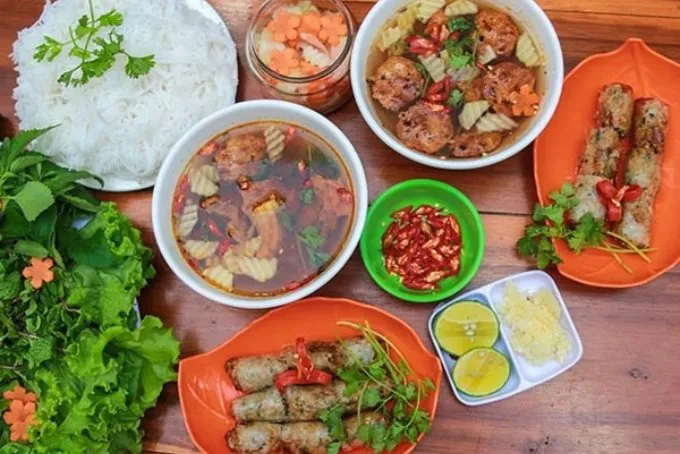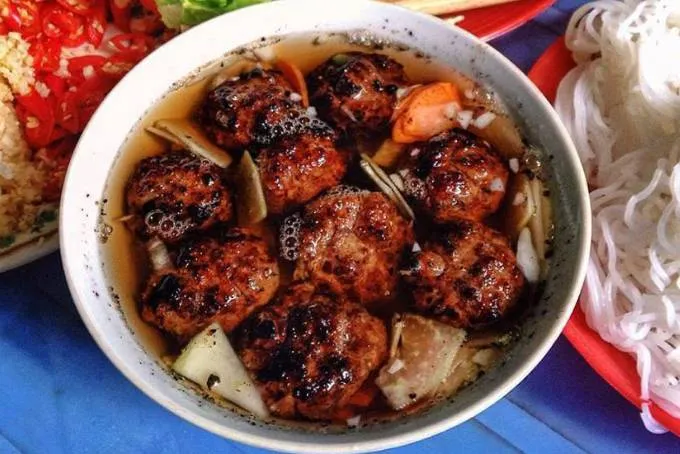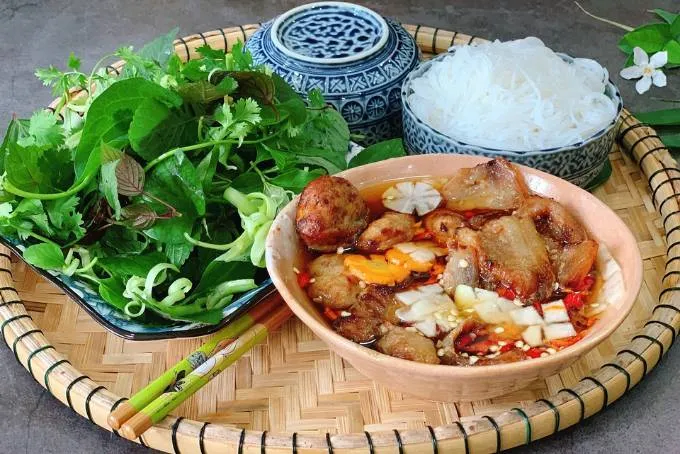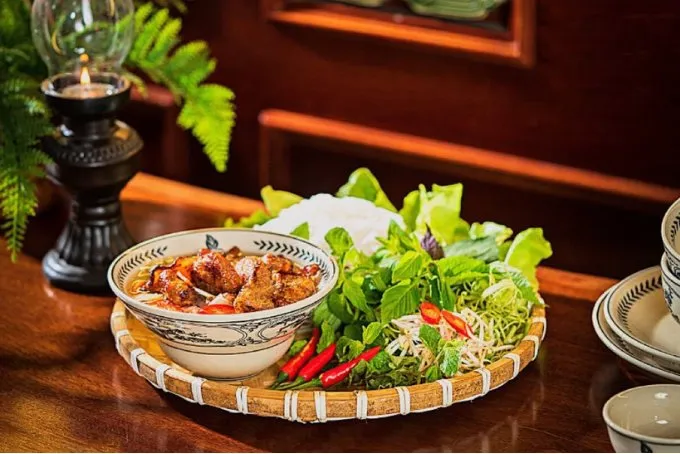Bun Cha Hanoi, a dish that seems simple yet embodies the sophisticated culinary culture of the Kinh Ky land. More than just a familiar food to Hanoians, bun cha is a source of pride, representing Vietnamese cuisine on the world map. But do you truly know how to enjoy traditional bun cha in a complete and authentic way? Join Discovery To Wonders to uncover the secrets to experiencing this dish perfectly, from the standard way of eating it like old Hanoians to the famous bun cha spots you can’t miss.
Bun Cha Hanoi – The Quintessence of Street Food in the Capital
Bun cha is not just a dish, but also a part of Hanoi’s culture, closely associated with the rhythm of life and the people here. From street vendors in the Old Quarter to upscale restaurants, bun cha weaves into every corner of the city, becoming a familiar and favorite dish for all ages.
Origin and History of Bun Cha
Few know that bun cha has a relatively long history of formation and development in Hanoi. This dish is believed to have appeared in the 20th century, initially just a rustic food, sold in markets or by street vendors. Over time, bun cha gradually asserted its position in the hearts of Hanoians and visitors from all over.
The name “bun cha” also partly speaks to the main ingredients of the dish: vermicelli (bun) and grilled pork (cha). However, the specialness of Hanoi bun cha lies not only in the ingredients but also in the meticulous preparation, unique flavor, and sophisticated way of enjoying it.
Distinctive Flavor That Makes Its Name
What makes the difference and attraction of Hanoi bun cha is its harmonious, delicate, and unmistakable flavor. The grilled pork is cooked over charcoal, bringing a characteristic aroma, combined with the rich sweetness of the meat and an appealing slightly charred edge. Soft fresh vermicelli, refreshing raw vegetables, and especially the perfectly balanced sweet and sour dipping sauce, all blend together to create an unforgettable symphony of flavors.
Bun cha is not only delicious but also provides nutritional balance. Grilled pork provides protein, vermicelli provides carbohydrates, and raw vegetables and dipping sauce supplement vitamins and minerals. This is an ideal dish for lunch or dinner, both delicious and filling without feeling heavy.
Exploring the Components of a Traditional Bun Cha Serving
A traditional serving of Hanoi bun cha is not fussy about ingredients, but each component is carefully selected and prepared to create a distinctive flavor.
Cha Mien, Cha Vien – A Perfect Combination
Cha (grilled pork) is the soul of bun cha, and there are usually two main types: cha mien (sliced grilled pork) and cha vien (grilled pork patties). Cha mien is made from thinly sliced pork belly, marinated with rich spices and then grilled over charcoal. Cha vien is made from ground pork shoulder, mixed with fat and spices, shaped into round patties and then grilled.
The combination of cha mien and cha vien in a serving of bun cha brings diversity in flavor and texture. Cha mien has a rich, slightly chewy taste, while cha vien is soft, sweet, and fatty. Old Hanoians often preferred to eat “mixed cha” bun cha to fully enjoy this distinctive flavor.
Fresh Vermicelli – An Indispensable Foundation
Fresh vermicelli (bun tuoi) is an indispensable component, playing a role in balancing the flavor and creating a feeling of fullness for bun cha. Good vermicelli must be the loose type, with small, ivory-white strands, soft but still maintaining a certain degree of chewiness, not mushy or broken when dipped in the dipping sauce.
Fresh vermicelli is usually made from delicious plain rice, undergoing a sophisticated process of soaking, grinding, filtering, pressing, boiling, and cooling. To get delicious vermicelli strands, the vermicelli maker must have experience and meticulousness in each step.
Raw Vegetables – A Refreshing Highlight
Raw vegetables are an indispensable side dish of Hanoi bun cha, helping to balance the taste and add a fresh flavor to the dish. The vegetables commonly served with bun cha are lettuce, perilla, kinh giới (Vietnamese balm), basil, diếp cá (fish mint), bean sprouts, etc.
Each type of vegetable brings a unique flavor, creating harmony and appeal when combined with bun cha. Raw vegetables not only make the dish more delicious but also provide fiber and vitamins, which are very good for health.
“Soul” Dipping Sauce – A Family Secret
The dipping sauce is considered the “soul” of Hanoi bun cha. A delicious bowl of dipping sauce must achieve a perfect balance between sour, spicy, salty, and sweet flavors. The dipping sauce is usually made from good fish sauce, sugar, rice vinegar, garlic, chili, and indispensable green papaya or pickled vegetables (dưa góp) sliced thinly.
Green papaya or pickled vegetables play an important role in creating a refreshing sour taste and crispness for the dipping sauce, while also balancing the saltiness of the fish sauce. The secret to making delicious dipping sauce is often passed down from generation to generation, and each bun cha restaurant has its own recipe, creating diversity and uniqueness for this dish.

Step-by-Step Guide to Enjoying Authentic Hanoi Bun Cha
To enjoy Hanoi bun cha completely and authentically, you can refer to the detailed guide below:
Step 1: Prepare and Arrange
A serving of bun cha is usually arranged quite simply but still very appealing. Vermicelli is placed separately on a plate or bamboo tray, grilled pork and dipping sauce are placed in a bowl or small bowl. Raw vegetables are arranged on a separate plate for diners to freely choose.
When eating bun cha, you should prepare chopsticks and a spoon. Old Hanoians often used large chopsticks to pick up vermicelli and grilled pork, and a spoon to scoop dipping sauce or eat with dipping sauce if desired.
Step 2: Adjust the Dipping Sauce (If Needed) and Taste
Usually, bun cha dipping sauce is already pre-mixed with a balanced flavor. However, if you want to adjust the flavor to suit your personal taste, you can add a little lime juice, chili, or minced garlic.
Before eating, you should taste the dipping sauce to feel the overall flavor. A delicious bowl of dipping sauce must have a harmonious balance of sour, spicy, salty, and sweet, not too strong nor too bland.
Step 3: Enjoy Bun Cha in 3 Traditional Ways
There are 3 traditional ways to enjoy Hanoi bun cha that you can choose from:
Method 1: Dip Vermicelli and Grilled Pork Together
This is a popular way of eating and favored by many Hanoians. You pick up vermicelli onto your plate, then put sliced grilled pork, grilled pork patties, papaya, and pickled vegetables into the bowl of dipping sauce. When eating, you use chopsticks to pick up each mouthful of vermicelli, dip it thoroughly into the bowl of dipping sauce that already contains grilled pork, and enjoy.
This way of eating helps the vermicelli absorb the rich flavor of the dipping sauce and grilled pork, very suitable for those who like a rich, complete flavor.
Method 2: Dip Vermicelli and Grilled Pork Separately
With this method, you arrange vermicelli and grilled pork on two separate plates. The dipping sauce is placed in a separate small bowl. When eating, you alternately pick up each piece of vermicelli and grilled pork, dip them into the bowl of dipping sauce, and then enjoy.
This way of eating allows you to adjust the amount of dipping sauce according to your taste, suitable for those who do not like to eat too salty or want to clearly feel the flavor of each component.
Method 3: Pour Dipping Sauce Over Bun Cha
This way of eating is less common than the two above methods, but it is also an interesting experience. You put all the vermicelli and grilled pork into a bowl, then pour the dipping sauce over it so that it covers the vermicelli and grilled pork. When eating, you use chopsticks to mix well and enjoy like eating mixed vermicelli.
This way of eating has the advantage of being quick and convenient, but it can cause the vermicelli to absorb too much dipping sauce, losing its chewiness and fresh flavor.


Step 4: Combine with Raw Vegetables and Seasonings
During the bun cha enjoyment, don’t forget to eat raw vegetables to add freshness and nutritional balance. You can eat raw vegetables separately or dip them into the bowl of dipping sauce along with vermicelli and grilled pork.
In addition to raw vegetables, you can also add a little seasoning such as pepper, fresh chili, or minced garlic to add more rich and appealing flavor to the dish.
Tips for a Complete Bun Cha Experience
- Choose a delicious and reputable bun cha restaurant: To enjoy authentic and delicious bun cha, you should find reputable bun cha restaurants that are loved by many locals.
- Eat bun cha while it’s hot: Bun cha is best when it’s freshly grilled, the grilled pork is still hot, and the dipping sauce is still warm.
- Enjoy slowly and savor: Enjoy bun cha slowly to fully appreciate the distinctive flavor of this dish.
Ideal Time to Enjoy Hanoi Bun Cha
Hanoi bun cha can be enjoyed at any time of the day, from morning, noon, afternoon to evening. However, according to many people’s experience, lunchtime is the most ideal time to enjoy this dish.
At noon, the weather is usually cool and pleasant, very suitable for enjoying a hot serving of bun cha. Moreover, bun cha is a filling dish, providing enough energy for an effective afternoon of work.
However, if you want to enjoy bun cha in the morning or evening, there is no problem either. Many bun cha restaurants are open all day to serve the needs of diners.
Addresses of Delicious and Famous Bun Cha Restaurants in Hanoi
Hanoi has countless bun cha restaurants, from affordable to luxurious. To help you easily choose, Discovery To Wonders suggests some addresses of delicious and famous bun cha restaurants that are loved by many:
- Bun Cha Huong Lien (Obama): The most famous bun cha restaurant in Hanoi, known for President Obama’s visit. Address: 24 Le Van Huu, Hai Ba Trung District.
- Bun Cha Dac Kim: A long-standing and famous bun cha restaurant in the Old Quarter. Address: 1 Hang Manh, Hoan Kiem District.
- Bun Cha Sinh Tu: A bun cha restaurant loved by many Hanoians. Address: 2 Nguyen Khuyen, Dong Da District.
- Bun Cha Que Tre (Bamboo Stick Bun Cha): A bun cha restaurant with traditional flavor, grilled pork is grilled on bamboo sticks. Address: 59 Lang Ha, Dong Da District.
- Bun Cha Hang Than: A bun cha restaurant with a distinctive flavor, rich dipping sauce. Address: 34 Hang Than, Ba Dinh District.
In addition, you can search for more delicious bun cha restaurants on Foody, GrabFood, Baemin apps or ask locals for more suitable options.
Cultural Significance and Culinary Value of Bun Cha
Hanoi bun cha is not just a delicious dish but also carries deep cultural and culinary values. This dish is a symbol of Hanoi street food, a source of pride for the people of the Capital, and an indispensable part of international tourists’ journey to discover Vietnamese culture.
Bun cha shows the sophistication and harmony in Vietnamese cuisine, from the selection of ingredients, meticulous preparation to the sophisticated way of enjoying it. This dish also reflects the cultural aspect of community dining, where people can enjoy bun cha together in roadside eateries, creating a warm and friendly atmosphere.

Conclusion
Traditional Hanoi bun cha is not just a delicious dish but also a unique cultural experience. Hopefully, with the detailed guide above, you have gained more knowledge and confidence to enjoy this special dish in the most complete way. Don’t forget to visit Hanoi and explore the famous bun cha restaurants to feel the authentic taste of the Capital’s cuisine! Wishing you memorable culinary experiences!